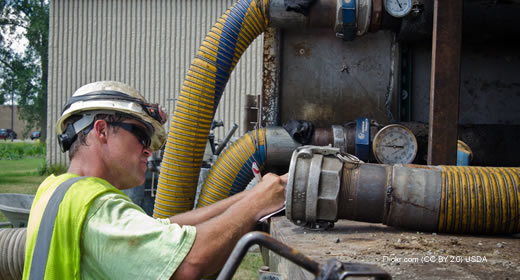
Over a quarter of local officials from Michigan jurisdictions that provide shared water infrastructure believe funding levels are not sufficient to maintain those systems, according to the latest Michigan Public Policy Survey (MPPS), "Local government leaders' views on drinking water and water supply infrastructure in Michigan communities."
In jurisdictions that provide shared delivery systems, 17 percent of local leaders believe there are threats to water quality or safety in their communities. This is also the case for 14 percent of officials in jurisdictions where citizens get their water through private wells.
These findings come from the latest MPPS report released by the University of Michigan’s Center for Local, State, and Urban Policy (CLOSUP), which conducts the survey twice a year to discover local government leaders’ opinions on a range of public policy issues. The latest report surveys officials on “issues related to the provision of drinking water in their communities,” including water safety, infrastructure, funding, and other challenges regarding shared local drinking water systems.
The provision of clean drinking water is an especially pertinent topic in Michigan since the Flint Water Crisis brought the state’s water infrastructure into the spotlight. From 2000 to 2012, Michigan ranked 46th in government infrastructure investment per capita. In 2013, the American Society of Civil Engineers reported Michigan would need to spend $13.8 billion in drinking water infrastructure over the next 20 years. The Michigan Infrastructure and Transportation Association estimates Michigan's investment in drinking water infrastructure is short by $284 to $563 million annually.
In this context, the MPPS asked local officials across Michigan about the state of their jurisdictions’ water systems.
Other key findings from the survey include:
- 55 percent of Michigan jurisdictions provide drinking water at least partially through shared water supply systems. 43 percent report citizens get water entirely through individual private wells.
- 37 percent of officials from jurisdictions with shared water systems report problems with aging and breaking pipes. This rises to 47 percent in the state’s largest jurisdictions, and to 55 percent in jurisdictions reporting high levels of municipal fiscal stress.
- In jurisdictions with shared water systems, 20 percent of local leaders say their water infrastructure is fair or poor. This number rises to 37 percent in jurisdictions suffering from high fiscal stress.
- 70 percent of officials in jurisdictions that charge water user fees report they have increased their rates in the last few years. 72 percent of local officials would support raising rates further to support infrastructure maintenance, but only 36 percent think the majority of their citizens would support this.
"While aging infrastructure and breaking water pipes are common problems, the most significant concern we found is the 17 percent of local leaders who report facing threats to the quality or safety of their local water sources," says CLOSUP Manager Tom Ivacko (MPA '93). "Beyond Flint, these new reports highlight challenges in many other Michigan communities."
The MPPS is conducted by CLOSUP in partnership with the Michigan Association of Counties, Michigan Municipal League, and Michigan Townships Association. The survey program is unique in the country as the only ongoing survey targeted at every unit of general purpose local government across an entire state.
MPPS surveys were sent between April 4 - June 6, 2016 to the top elected and appointed officials from all 83 Michigan counties. A total of 1,378 jurisdictions returned valid surveys, a 74 percent response rate. The margin of error was 1.34 percent.
More news from the Ford School